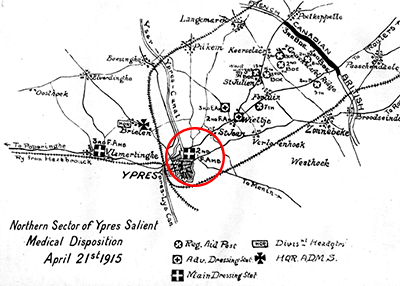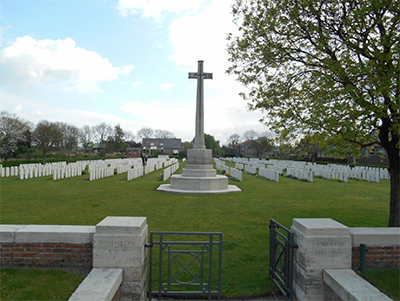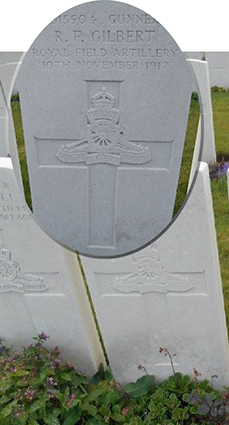First World War Project
Reginald Frank GILBERT (of Lynsted)
b. December 1894 Gunner, Service Number 915504 |

Confusingly, Reginald was registered at birth as "Frank Reginald" in December 1894 and christened the same on 16 January 1895 in Teynham Church. Thereafter, Frank is registered as "Reginald Frank" in census data and military records.
Reginald was born in Greenstreet, Teynham, and was one of the 11 children of Abraham and Amy (née Kensley). Reginald's older siblings were Percy William1, Archibald2, Mildred Kate, Violet Ethel and Edith Nora, and younger siblings Hilda Winifred, John Maxwell, Cuthbert Eric and Sybil Irene. In 1900 another daughter was born but died only hours old. His father was a self-employed carpenter and fencer and Reginald would eventually work alongside his father in the business.
NOTES:- Reginald's older brother, Percy died aged 18 in 1901, while serving as a private in the 10th Hussars, following hospitalisation in St James's Hospital, Woolwich. Percy is buried in Teynham Churchyard. His other older brother, Archibald, served in the Royal Navy in both World Wars and died while stationed at HMS Pembroke, the Naval land base at Chatham, while on active service on 30 June 1942. At the time of his death his rank was Chief Stoker. He is buried in the Lynsted Church Extension Churchyard along with their sister Edith Nora. |
Although born on the Teynham side of Greenstreet, he would live the majority of his short life on the Lynsted side. The house no longer exists but it would have been situated near the entrance to the Coffin Path on London Road.
We know that he enlisted in Sittingbourne in February 1915. As conscription was not yet in place, he was obviously a volunteer. However, we have no evidence that his service records survived. Although we have no concrete details of Reginald's service, we are able to tell his story via the Regimental records and war diaries of "D" Bty 223rd Brigade, Royal Field Artillery (RFA).
The records show that Reginald's regiment was first mobilised on 1 July 1916, leaving Heytesbury, Wiltshire, for embarkation from Southampton. It comprised 32 Officers and 809 ORs; 664 Horses (176 Riding; 196 Light Draught; 292 Medium). The RFA were responsible for medium calibre guns and Howitzers. "C" Battery suffered the first casualty of the 223rd Brigade on the day they disembarked at Le Havre, when Dr Waller fell off his horse and broke his leg.
As they arrived in France, it appears there were only three Batteries ("A", "B"" and "C"). They were first located in Bryas (Brias) and Grossart, securing and loading ammunition, and officers attending briefings on cooperation between artillery and aeroplanes. On 12 April, they moved 5 kilometres eastwards to La Thieuloy, Bully Grenay and Barlin.
On 18 July, at Barlin the records note:
"From this day, Howitzer battery (late "A" Battery, 223rd Brigade) attached to this Brigade."
Then, on 19 July:
"R.N.D.A.O. (Royal Navy Division Artillery Officer) 19 number of Brigade changed from 318th to 225th."
On 31 July, the number of the Brigade again changed from 225 to 223 Brigade.
The brigade's next casualties also were again the result of an accident when, on 1 August 1916, at Aix-Noulette, when a Gunner shot his finger off through careless handling of his rifle. This event inflicted wounds to a Sergeant and one other man. All the men were taken to an Advance Dressing Station but only one was fit to return to duty
During August, the Battery were chiefly involved in day and night harassing and searching fire on tracks and roads in the Brigade Zone; destruction of trenches in Brigade Zone by 4.5" howitzers; retaliation on enemy trench mortars; gas bombardments; registration of new targets and sniping of working parties.
The Brigade added to its strength at the end of August when "A" Battery 316 Brigade and one section of "B" Battery 316 were transferred to the 223 Brigade.
The Brigade gained experience by visiting battery positions near Mesnil on 18 October, immediately suffering casualties, losing 1 and injuring 2 more with eight horses lost belonging to "A" Battery. Also, 370 horses were withdrawn to Famechon to alleviate congestion at Wagon Lines.
With winter in prospect, increasing efforts turned to hardening defence of gun-pits and erection of Nissen huts and horse standings at the Brigade wagon lines. Orders were also issued that each Battery should prepare and care-take alternative positions that might be occupied at short notice. The idea being that enemy counter attacks would be more difficult and ammunition would be turned over regularly.
The Brigade was ordered "out of the line" on 30 November 1916, withdrawing by stages to Grand Laviers. But sadly Reginald's Battery suffered its first losses on 31 November 1916 when 2 sergeants were killed by gas shells.
Early in 1917, the Brigade moved batteries into positions near Thiepval and just South of the River Ancre (HQ in Authuille). Here they gained more experience of practice barrages to disrupt German working parties. The RFA also began to explore the use of "106 Fuses" in their shells as it was found "that this Fuse in conjunction with 18-pound Heavy Explosive forms a most valuable projectile for wire cutting, as well as for general man-killing and wood searching."
The Brigade would take part in the First and Second Battles of the Scarpe, including the capture of Guemappe during the Arras Offensive.
Moving to the latter part of 1917, in early October, Reginald was in the area of Poelcappelle, Belgium, the Brigade was at Frevin Capelle early in October. On the 8 October, instructions were received that the Divisional Artillery would move from the First Army to join its Division in the Fifth Army.
As we get closer to the action in which Reginald received his fatal wounds, the war diary reports:
| Date | Operations |
| 10/11 October 1917 | Units entrained at Savy according to time table, and detrained at Poperinghe. After detrainment Brigade HQ and Batteries marched to Wagon Lines as under:- A.28.c.5.7. (de Zon Cabaret). HQ, "C" and "D"/223 on West side of Poperinghe-Elverdineghe Road. "A" and "B"/223 on East side of the Road. |
| 18/19 October | Much difficulty was experienced in preparing all the Battery positions near St Julien [Sint-Juliaan], owing to the wet state of the ground, and the heavy counter battery work, and shelling of roads and tracks by the enemy. There was also a lack of cover for personnel at the gun positions. In spite of this, very successful efforts were made by the Batteries of the Group to get up their full complement of guns, and sufficient ammunition for the Operations timed to take place on 22 October. |
| 22 October | 5.35 a.m.: The Group took part in barrage to cover attack as per instructions in 9 Divisional Artillery Operation Order No.162. The Brigade had by this time 17 18-pounders and 5 Howitzers in action. (Total for Group – 18-pounders 35; 4.5=Howitzers, 6). All the Batteries were heavily shelled during the Operation. Four of the Howitzers of "D"/223 were put out of action, but the personnel, in a most praiseworthy manner continued to work the one remaining gun, until ordered to cease fire. "A", "B", and "D"/223 Batteries were ordered by H.Q. 9 Divisional Artillery to be 'Silent Batteries', and had not to fire in case of an S.O.S." |
| 25 October | Bombardment continued, also work on positions, salving guns, and drawing up ammunition. 12 noon: The Group came under orders of H.Q. 63rd (R.N.) Divisional Artillery Operation Order no.120 (B,C,D/317 and "A", "B", "C" and "D"/223 firing). Firing was kept up during the day as situation demanded. The barrage was reported to have been quite satisfactory."B"/223 suffered several casualties from enemy fire, but the other Batteries fortunately escaped any severe losses. S.O.S. Lines at the end of the day were from V.28.a.17.80 to V.21.c.55.10. |
| 28 October | 6.30 a.m.: Under instructions contained in 63rd (R.N.) Divisional Artillery Operation Order No.124 a further 48 hours bombardment was commenced. (B, C and D/317 and A, B, C, and D/223 took part). The Headquarters of the Brigade were relieved in the line by H.Q. 317 Brigade, R.F.A. who took over administration of No.4 Group. 9.0 a.m.: The Group Commander (Lt. Col. W.E. Wingfield, D.S.O.) checked the S.O.S. barrage of the Batteries. 29 October Bombardment continued. Batteries were ordered that they must have 1,300 rounds per 18-pounder and 800 rounds per 4.5" Howitzers at the guns by the morning of 30th. Arrangements were made accordingly. Under instructions from Divisional Artillery, H.Q., C/223 Battery were relieved in action by A/291 Battery, at 6.0 am C/223 were accommodated at the Brigade Wagon Lines. |
| 30 October | The attack was resumed by 63rd (R.N.) Divisional Artillery Operation Order No.127, and Batteries of the Group put up a barrage as ordered. (For details of work carried out by Batteries from 29 to 31 see War Diary of 317th Brigade, R.F.A.). |
| 31 October | 10.30 p.m.: The Wagon Lines of the Brigade were bombed by hostile aeroplanes. Casualties inflicted were, 1 man killed, 6 wounded, 7 horses killed and 33 wounded. |
During these operations one Military Cross and 4 Military Medals were awarded to men of "D"/223 Battery.
The Brigade continued in action near St Julien during November, and along with 317th Brigade, RFA, constituted No 4 Group of Right Divisional Artillery, II Corps. The Group was under administration of its own Divisional Artillery HQ from 1 November to 10am, 5 November, when HQ 1st (Imperial) Divisional Artillery took over. The latter remained in Command until 23 November, when they were relieved by HQ 32nd Divisional Artillery.
The HQ of this Brigade, under Lieut Colonel W E Wingfield, DSO, was in Command of No 4 Group from 6 am on 8 November to 10am on 19 November. During the remainder of the month the Group was under the command of HQ, 317th Brigade, RFA.
Group HQ, battery positions and wagon lines remained the same as in October up to the night 16/17 November, when three batteries of the Group moved to advanced positions in the Stroombeek Valley.
The operations in which the batteries were engaged during the month were chiefly heavy bursts of fire directed on hostile main lines of resistance and on forward lines of resistance. Zero hours and targets for the bursts were detailed by the HQ Divisional Artillery, and were of varying intensity and duration. Harassing fire on enemy roads and approaches and selected targets was also carried out each night, periods and targets being detailed from HQ Divisional Artillery.
There is no information that enables us to identify when Reginald received his wounds, but the last few days of his life included the actions noted in this extract from the war diary:
| Date | Operations |
| 1-5 November 1917 | Batteries carried out registration and calibration, also barrages etc, detailed by H.Q. 63rd (R.N.) Divisional Artillery. 4th: 2/Lieut. C.G. Wilson posted from H.Q. to A/223 Battery. |
| 6 (8am) - 9 November | "C"/223 Battery relieved "A"/317 Battery in action. Barrages as detailed in 1st Divisional Artillery Operation Orders Nos. 11 and 12, and night harassing fire carried out by Batteries. 7th November: Lt. A.R. Muir, "B"/223 died of wounds (gas). |
| 10 November | 6.5 a.m.: Batteries took part in barrage to cover attack by Infantry of 1st (Imperial) Division, and as detailed in 1st. Divisional Artillery Operation Order No.13 dated 8.11.17. |
| 11-15 November | Batteries carried out bursts of fire and night firing as detailed by H.Q. 1st Divisional Artillery. 13th November, 9 a.m.: "A"/317 Battery relieved "A"/223 Battery in action. The 18-pounder Batteries of the Group were rested in turn during the month, the period of rest being 7 days. |
 Poignantly the war diary starts a report noting the number of casualties during these actions. "Casualties in action: Killed or Died of Wounds, 1 Officer....." The diary remains incomplete.
Poignantly the war diary starts a report noting the number of casualties during these actions. "Casualties in action: Killed or Died of Wounds, 1 Officer....." The diary remains incomplete.
Reginald died of wounds, caused by shellfire, in the 2nd Corps Main Dressing Station just outside Ypres on 10 November 1917.
| Faversham and North East Kent News of 24th November 1917 |
GUNNER R. F. GILBERT, R.F.A. Another Lynsted man killed is Gunner Reginald Frank Gilbert, R.F.A., son of Mr. Abraham Gilbert, of Greenstreet. He joined up in January 1915, and had been at the Front for almost two years. He was home for a few days during the past summer. News of his death was received last week by his father, a chaplain writing: "Your brave son was killed in action on the 9th." Other letters were received from one of the officers and a comrade. Gunner Gilbert was 23 years of age, and he was formerly in Lynsted Choir. Another son of Mr Gilberts has been serving in the Navy for 11 years. |
He was awarded posthumously the British War and Victory Medals. [See Appendix 1]
In March 1918, his father received the money owed amounting to £12 8s 11d (£8.44½). In November 1918 he also received the War Gratuity of £13. [See Appendix 2] Taken together these amount to roughly £1,335 in today's money.
Reginald is buried in Duhallow Advanced Dressing Station (ADS), Cemetery, Ieper, West-Vlaanderen, Belgium, Grave Ref: III.B.8. Duhallow is believed to be named after a Southern Irish hunt and lies 1.6 kilometres north of Ypres.
Reginald's death coincide with the last day of the 3rd Battle of Ypres (Passchendaele).
 |
 |
Photographs courtesy of Paul and Karen Fawcett.
Reginald's death coincided with the last day of the 3rd Battle of Ypres (Passchendaele).

 World War 1 Pages
World War 1 Pages